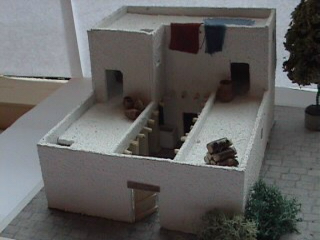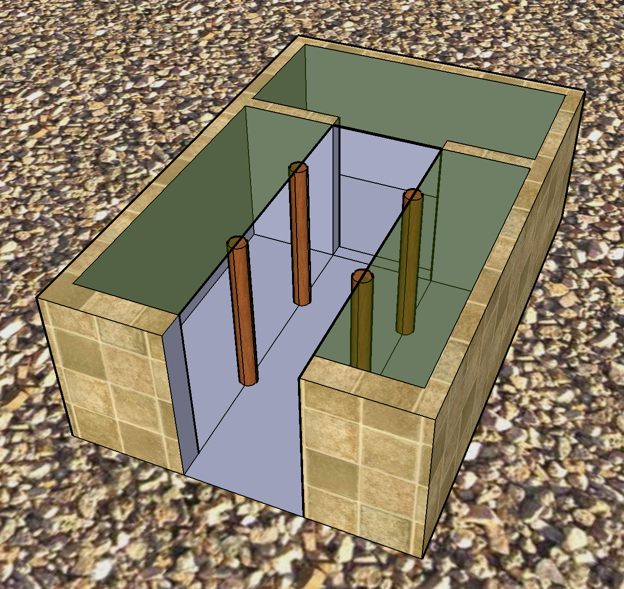Four room house on:
[Wikipedia]
[Google]
[Amazon]


 A four-room house, also known as an "Israelite house" or a "pillared house" is the name given to the mud and stone houses characteristic of the
A four-room house, also known as an "Israelite house" or a "pillared house" is the name given to the mud and stone houses characteristic of the


 A four-room house, also known as an "Israelite house" or a "pillared house" is the name given to the mud and stone houses characteristic of the
A four-room house, also known as an "Israelite house" or a "pillared house" is the name given to the mud and stone houses characteristic of the Iron Age
The Iron Age is the final epoch of the three-age division of the prehistory and protohistory of humanity. It was preceded by the Stone Age ( Paleolithic, Mesolithic, Neolithic) and the Bronze Age ( Chalcolithic). The concept has been mostl ...
of Levant
The Levant () is an approximate historical geographical term referring to a large area in the Eastern Mediterranean region of Western Asia. In its narrowest sense, which is in use today in archaeology and other cultural contexts, it is ...
.
The four-room house is so named because its floor plan is divided into four sections, although not all four are proper rooms, one often being an unroofed courtyard
A courtyard or court is a circumscribed area, often surrounded by a building or complex, that is open to the sky.
Courtyards are common elements in both Western and Eastern building patterns and have been used by both ancient and contemporary ...
. It is also sometimes called a pillared house because two—or all three—of the parallel ground-level "rooms" are separated by one—or two, respectively—rows of wooden pillars. The pillars, however, are not the defining feature of the four-room house, and this error of terminology leads to the confusion of four-room houses with other buildings, such as storehouses and stables, where pillars were widely used, but which were not constructed under the four-room house layout. When an upper floor was included, the inhabitants used it as living quarters, while the ground floor was used as a stable for livestock
Livestock are the domesticated animals raised in an agricultural setting to provide labor and produce diversified products for consumption such as meat, eggs, milk, fur, leather, and wool. The term is sometimes used to refer solely to animal ...
and for storage. There were multiple variations on the basic four-room house. Some had a five-, three-, or two-room layout, and sometimes the rooms were divided by additional walls into smaller areas. Acknowledging these sub-types of the four-room house, the popularity of the structure started at the beginning of Iron Age I (end of the eleventh century BCE) and dominated the architecture of Israel
Israel (; he, יִשְׂרָאֵל, ; ar, إِسْرَائِيل, ), officially the State of Israel ( he, מְדִינַת יִשְׂרָאֵל, label=none, translit=Medīnat Yīsrāʾēl; ), is a country in Western Asia. It is situated ...
through Iron Age II until the Babylonian Exile. After the destruction of Judah (of the seventh and sixth centuries BCE) the architecture type was no longer utilized.
Analysis
There have been multiple theories on why the four-room house construction was so popular. Architectural analysis can be made of the residential units by the way they are grouped, the relationship between structures, their size, internal divisions, and the size and structure of the families that inhabited them. Various points can be made about the four-room house pertaining to the culture of their inhabitants. Disparity in house sizes and build quality within towns seem to be a result of socio-economic stratification within cities. Four-roomed houses are found in isolation or built in clusters of grouped units. It can be observed that smaller urban houses, that shared walls between them, were most likely inhabited by nuclear families, while the larger stand-alone houses belonged to extended and wealthy families such as the urban elite. Through the analysis of space syntax within the four-room house, it can be said that the four-room house reflects anegalitarian
Egalitarianism (), or equalitarianism, is a school of thought within political philosophy that builds from the concept of social equality, prioritizing it for all people. Egalitarian doctrines are generally characterized by the idea that all hu ...
ideology. The typical four-room house had a layout where all the inner rooms were directly accessible from the house's central space, suggesting that all rooms were equal and there was no hierarchy to the space. The four-room house was unlike the typical Canaanite-Phoenician dwelling, which had a layout where some rooms could be entered only by passing through other rooms, hence showing a hierarchy of access.
Although sometimes considered particularly Israelite, this idea has been challenged. Ziony Zevit
Ziony Zevit (born February 13, 1942) is an American scholar of biblical literature and Northwest Semitic languages, and a professor at the American Jewish University.
Biography
Zevit received his B.A. degree from University of Southern CA in 1 ...
writes that although " e Iron Age pillared houses, the "four-room house," are not uniquely Israelite", listing up several Iron Age non-Israelite sites where such houses were found, he nevertheless states that they are unlike the older, "Late Bronze II pillared house discovered at Tel Batash
Timnath or Timnah was a Philistine city in Canaan that is mentioned in the Hebrew Bible in and in connection with Samson. Modern archaeologists identify the ancient site with a tell lying on a flat, alluvial plain, located in the Sorek Valley ...
", and finally concludes that, all considered, "they are characteristic of Israelite sites." Their origins are uncertain.
Building patterns and materials
Through archaeological excavations and anthropological studies, it is possible to report on building materials and possible methods used in the construction of the Israelite four-room houses. The Iron I four-room houses typically measured ten to twelve meters long and eight to ten meters wide. The floor plan consists of three axial rooms, connected by one “broadroom" at the rear of the building. Although a majority of houses were not found standing, through analysis it can be concluded that some houses stood two stories tall. Not all four-room houses were stand-alone houses in the typical American sense. While some houses were found in isolation, other houses were found with shared walls, and even shared the back broadroom wall with a thicker, outer, defensive city wall. The houses could be constructed in a circular pattern, where the outer city wall connected all back broadroom walls, such as in a combination of the casemate wall and the residential wall. The normal walls were around one meter thick, and were constructed of fieldstones. The exterior defensive walls were thicker. The surfaces of exterior walls were likely plastered to prevent erosion from rainfall, which could be heavy and intense in the winter and spring of the region. The plastering would have demanded a significant quantity of lime to be manufactured, which required akiln
A kiln is a thermally insulated chamber, a type of oven, that produces temperatures sufficient to complete some process, such as hardening, drying, or chemical changes. Kilns have been used for millennia to turn objects made from clay int ...
. The floors were composed of beaten earth and flagstone pavement. Finely layered ash and clay helped keep the floors smooth and level. As seen by the sheer volume and weight of all of the stones, wooden pillars, and mudbrick walls used in the construction of the four-room house, it can be said that construction was a team effort that took a lot of energy.
List of Sites with Four Room House
Following is a tentative list of Israelite Four Room houses at various excavation sites. * Avaris (Land of Goshen
The land of Goshen ( he, אֶרֶץ גֹּשֶׁן, Modern: ''ʾEreẓ Gōšen'', Tiberian: ''ʾEreṣ Gōšen'') is named in the Hebrew Bible as the place in Egypt given to the Hebrews by the pharaoh of Joseph (Book of Genesis, ), and the ...
?)
* City of David (Jerusalem
Jerusalem (; he, יְרוּשָׁלַיִם ; ar, القُدس ) (combining the Biblical and common usage Arabic names); grc, Ἱερουσαλήμ/Ἰεροσόλυμα, Hierousalḗm/Hierosóluma; hy, Երուսաղեմ, Erusałēm. i ...
)
* Isbet Sartah
* Lachish
Lachish ( he, לכיש; grc, Λαχίς; la, Lachis) was an ancient Canaanite and Israelite city in the Shephelah ("lowlands of Judea") region of Israel, on the South bank of the Lakhish River, mentioned several times in the Hebrew Bible. Th ...
* Mitzpe Ramon
Mitzpe Ramon ( he, מִצְפֵּה רָמוֹן, Ramon Lookout; ar, متسبي رمون) is a local council in the Negev desert of southern Israel. It is situated on the northern ridge at an elevation of 860 meters (2,800 feet) overlo ...
* Tell Abu al-Kharaz Tell Abu al-Kharaz () is an archeological tell in the Irbid Governorate of modern-day Jordan. Tell Abu al-Kharaz was the site of a fortified town during the Bronze and Iron Ages; it is located in the Jordan Valley, 4 kilometers east of the Jordan ...
* Tel Arad
Tel Arad ( he, תל ערד), in Arabic Tell 'Arad (تل عراد), is an archaeological tell, or mound, located west of the Dead Sea, about west of the modern Israeli city of Arad in an area surrounded by mountain ridges which is known as the ...
* Tel Be'er Sheva
Tel Sheva ( he, תל שבע, translit=) or Tel Be'er Sheva (), also known as Tell es-Seba (), is an archaeological site in the Southern District of Israel, believed to be the site of the ancient biblical town of Beer-sheba. The site lies east o ...
(Beersheba
Beersheba or Beer Sheva, officially Be'er-Sheva ( he, בְּאֵר שֶׁבַע, ''Bəʾēr Ševaʿ'', ; ar, بئر السبع, Biʾr as-Sabʿ, Well of the Oath or Well of the Seven), is the largest city in the Negev desert of southern Israel. ...
)
* Tel Hazor
Tel Hazor ( he, תל חצור), also Chatsôr ( he, חָצוֹר), translated in LXX as Hasōr ( grc, Άσώρ), identified at Tell Waqqas / Tell Qedah el-Gul ( ar, تل القدح, Tell el-Qedah), is an archaeological tell at the site of anci ...
* Tel Megiddo
Tel Megiddo ( he, תל מגידו; ar, مجیدو, Tell el- Mutesellim, ''lit.'' "Mound of the Governor"; gr, Μεγιδδώ, Megiddo) is the site of the ancient city of Megiddo, the remains of which form a tell (archaeological mound), situa ...
* Tel Mevorakh
* Tel Rumeida (Hebron
Hebron ( ar, الخليل or ; he, חֶבְרוֹן ) is a Palestinian. city in the southern West Bank, south of Jerusalem. Nestled in the Judaean Mountains, it lies above sea level. The second-largest city in the West Bank (after Eas ...
)
* Tel Shikmona
Tel Shikmona ( he, תל שִׁקְמוֹנָה, translit= Šiqmônah), or Tell es-Samak ( ar, تل السمك, translit=Tell as-Samak), also spelt Sycamine, is an ancient Phoenician tell (mound) situated near the sea coast in the modern city of ...
* Tell Qasile
Tell Qasile is an archaeological site near the Yarkon River in Tel Aviv, Israel. Over 3,000 years old, the site contains the remains of a port city founded by the Philistines in the 12th century BC.
Prior to 1948, it was on the village lands of ...
See also
*History of ancient Israel and Judah
The history of ancient Israel and Judah begins in the Southern Levant during the Late Bronze Age and Early Iron Age. "Israel" as a people or tribal confederation (see Israelites) appears for the first time in the Merneptah Stele, an inscri ...
* Israelites
The Israelites (; , , ) were a group of Semitic-speaking tribes in the ancient Near East who, during the Iron Age, inhabited a part of Canaan.
The earliest recorded evidence of a people by the name of Israel appears in the Merneptah Stele o ...
References
{{Israelites Archaeology of Israel House types Ancient Jewish history Ancient Israel and Judah Vernacular architecture Ancient Near East art and architecture